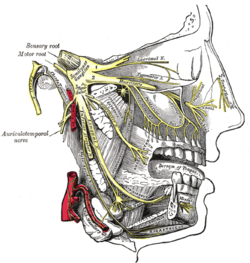Loading AI tools
Small nerve of the face From Wikipedia, the free encyclopedia
The zygomaticotemporal nerve (zygomaticotemporal branch, temporal branch) is a cutaneous (sensory) nerve of the head.[1] It is a branch of the zygomatic nerve (itself a branch of the maxillary nerve (CN V2)). It arises in the orbit and exits the orbit through the zygomaticotemporal foramen in the zygomatic bone to enter the temporal fossa. It is distributed to the skin of the side of the forehead. It also contains a parasympathetic secretomotor component for the lacrimal gland which it confers to the lacrimal nerve (which then delivers it to the gland).
| Zygomaticotemporal nerve | |
|---|---|
 | |
| Details | |
| From | Maxillary nerve |
| Innervates | Skin on side of forehead |
| Identifiers | |
| Latin | ramus zygomaticotemporalis nervi zygomatici |
| TA98 | A14.2.01.057 |
| TA2 | 6232 |
| FMA | 52972 |
| Anatomical terms of neuroanatomy | |
The zygomaticotemporal nerve is a branch of the zygomatic nerve.[2]: 496
It passes along the lateral wall of the orbit in a groove in the zygomatic bone.[3]
It passes through the zygomaticotemporal foramen of the zygomatic bone[4] to emerge (at the anterior portion of) the temporal fossa.[1]
In the temporal fossa, it passes superior-ward[5] between the two layers of the temporal fascia,[2]: 357 between the temporal bone and temporalis muscle. It pierces the temporal fascia about 2 cm superior to the zygomatic arch.[1]
As it pierces the deep layer of temporal fascia, it issues a small branch which runs between the two layers of the temporalis fascia to the lateral angle of the orbit.[1]
The nerve provides sensory innervation to a small area of skin[2]: 354 over the temple[1][2]: 354, 356 superior to the zygomatic arch.[2]: 496
The zygomaticotemporal nerve communicates with the facial nerve (CN VII) (in most individuals[6]),[1][6] the lacrimal nerve (a branch of the ophthalmic nerve (CN V1)),[2]: 495 and the auriculotemporal nerve (a branch of the mandibular nerve (CN V3)).[1]
Sometimes, the zygomaticotemporal nerve replaces the lacrimal nerve and vice versa.[1]
Seamless Wikipedia browsing. On steroids.
Every time you click a link to Wikipedia, Wiktionary or Wikiquote in your browser's search results, it will show the modern Wikiwand interface.
Wikiwand extension is a five stars, simple, with minimum permission required to keep your browsing private, safe and transparent.